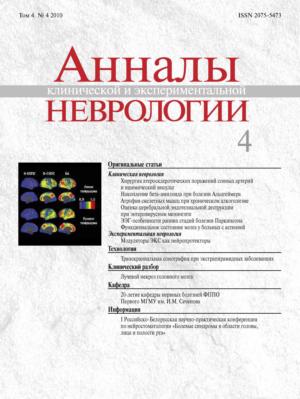Клинико-электроэнцефалографический анализ ранних стадий болезни Паркинсона
- Авторы: Титова Н.В.1, Катунина Е.A.1, Олейникова O.M.1, Лагутин Ю.В.1, Бездольный Ю.Н.1, Авакян Г.Н.1
-
Учреждения:
- Российский государственный медицинский университет
- Выпуск: Том 4, № 4 (2010)
- Страницы: 25-30
- Раздел: Оригинальные статьи
- Дата подачи: 03.02.2017
- Дата публикации: 13.02.2017
- URL: https://annaly-nevrologii.com/journal/pathID/article/view/325
- DOI: https://doi.org/10.17816/psaic325
- ID: 325
Цитировать
Полный текст
Аннотация
Статья посвящена определению нейрофизиологических особенностей ранних стадий болезни Паркинсона (БП) с помощью компьютеризированного электроэнцефалографического исследования (ЭЭГ). Полученные данные демонстрируют, что уже для дебюта БП характерно изменение биоэлектрической активности головного мозга. При дрожательной форме выявлено преимущественно увеличение процентной мощности в дельта- и тета-диапазонах, уменьшение пиковой частоты альфа-ритма и повышение мощности альфа 1-активности относительно альфа-3. Для акинетико-ригидной формы характерно снижение абсолютной и процентной мощности в диапазонах бета-1- и бета-2-активности. Правосторонний дебют заболевания сочетается с более грубыми нарушениями на ЭЭГ (особенно при акинетико-ригидной форме) при отсутствии различий между группами по длительности, возрасту дебюта заболевания и выраженности симптоматики, что может иметь прогностическое значение на начальных стадиях БП. Динамика ЭЭГ-показателей выражалась в нарастании мощности медленноволновой активности и снижении спектральной мощности в бета-частотном диапазоне независимо от факта назначения лечения и группы применяемых препаратов.
Ключевые слова
Об авторах
Н. В. Титова
Российский государственный медицинский университет
Email: nattitova@yandex.ru
Россия, Москва
Е. A. Катунина
Российский государственный медицинский университет
Email: nattitova@yandex.ru
Россия, Москва
O. M. Олейникова
Российский государственный медицинский университет
Email: nattitova@yandex.ru
Россия, Москва
Ю. В. Лагутин
Российский государственный медицинский университет
Email: nattitova@yandex.ru
Россия, Москва
Ю. Н. Бездольный
Российский государственный медицинский университет
Email: nattitova@yandex.ru
Россия, Москва
Г. Н. Авакян
Российский государственный медицинский университет
Автор, ответственный за переписку.
Email: nattitova@yandex.ru
Россия, Москва
Список литературы
- Атаджанов М.А. Экспериментальное моделирование паркинсонического синдрома и его комплексная патогенетическая терапия: Автореф. дис. …докт. мед. наук. М., 1989.
- Голубев В.Л., Левин Я.И., Вейн А.М. Болезнь Паркинсона и синдром паркинсонизма. М.: МЕДпресс-Информ, 1999.
- Голубев В.Л., Левин Я.И., Шамликашвили Ц.А. Латерализованные формы паркинсонизма (клинические, электрофизиологические и психомоторные аспекты). Журн. неврол. и психиатрии им. С.С. Корсакова 1989; 11: 119–123.
- Крыжановский Г.Н., Атаджанов М.А., Магаева С.В. и др. Изменение ЭЭГ и явления паркинсонизма при интракаудатном введении антител к дофамину. Бюл. экспер. биол. и мед. 1989; 1: 13–16.
- Маньковский Н.Б., Кузнецова С.М. Интегративная деятельность мозга. В кн.: Фролькис В.В. (ред.) Старение мозга. М.: Медицина, 1991: 93–113.
- Садикова О.Н. Корреляция клинических, нейропсихологических и компьютерно-томографических данных при болезни Паркинсона. Автореф. дис. … канд. мед. наук. М., 1997.
- Стариков А.С. Нейрофизиологический и нейроморфологический анализ болезни Паркинсона и ее лечение стереотаксическим методом. Журн. неврол. и психиатрии им. С.С. Корсакова 2004; 11: 29–33.
- Фокина Ю.О., Павленко В.Б., Куличенко А.М. Вероятные механизмы генерации электроэнцефалограммы. Ученые записки Таврического национального университета им. В.И. Вернадского. Серия «Биология, химия» 2007; 4: 96–108.
- Яхно Н.Н., Дамулин И.В., Гончаров О.А. Сравнительная оценка различных форм паркинсонизма у больных пожилого и старческого возраста (клиническое, нейропсихологическое и компьютерно-томографическое исследование). Журн. неврол. и психиатрии им. С.С. Корсакова 1992; 1: 67–72.
- Berendse H.W., Stam C.J. Stage-dependent patterns of disturbed neural synchrony in Parkinson’s disease. Parkinsonism Relat. Disord. 2007; 13: 440–445.
- Braak H., Del Tredici K., Rob U. et al. Staging of brain pathology related to sporadic Parkinson’s disease. Neurobiol. Aging 2003; 24: 197–211.
- Limousine Dowsey P., Pollak P., Van Blercom N. Thalamic, subthalamic nucleus and internal pallidum stimulation in Parkinson’ disease. Neurology 1999; 246: 1142–1145.
- Moro E., Scerrati M., Romito L.M. et al. Chronic subthalamic nucleus stimulation reduces medication requirements in Parkinson’s disease. Neurology 1999; 53: 85–90.
- Neufeld M.Y., Blumen S., Aitkin I. et al. EEG frequency analysis in dementia and nondemented parkinsonian patients. Dementia 1994; 5: 23–28.
- Olanow C.W., Koller W.C. An algorithm (decision tree) for the management of Parkinson’s disease. Neurology 1998; 50: 1–57.
- Soikkelli R., Partanen J., Soinen H. Slowing of EEG in Parkinsons disease. Electroenceph. Clin. Neurophysiol. 1991; 79: 159–165.
- Staffers D., Bosboom J.L., Deijen J.B. et al. Slowing of oscillatory brain activity is a stable characteristic of Parkinson’s disease without dementia. Brain 2007; 130: 1847–1860.
- Staffers D., Bosboom J.L.W., Deijen J.B. et al. Dopamine dependent changes in resting-state functional connectivity in mild to moderate levodopa-treated Parkinson’s disease. Parkinsonism Relat. Disord. 2007; 13: 149–150.
- Stam C.J., Jelles В., Achtereekte H.A. et al. Investigation of EEG nonlinearity in dementia and Parkinson’s disease. Electroenceph. Clin. Neurophysiol. 1995; 95: 309–317.
- Wolters E.Ch., Francot Ch., Bergmans P. Preclinical (premotor) Parkinson’s disease. J. Neurol. 2000; 247: 103–109.
Дополнительные файлы









